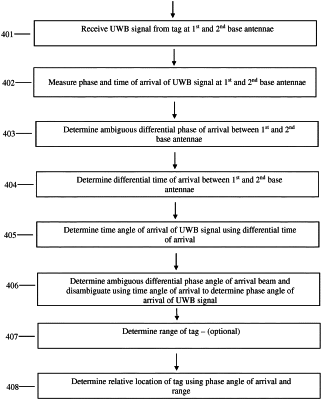| CPC G01S 3/50 (2013.01) [G01S 5/04 (2013.01); G01S 5/12 (2013.01); G01S 13/0209 (2013.01); G01S 13/878 (2013.01)] | 21 Claims |

|
1. A system for determining a position of a tag antenna, comprising:
a first pair of spaced apart fixed base antennae including two antennae; and
a second pair of spaced apart fixed base antennae including two antennae, wherein at least one base antenna of the first pair of base antennae and at least one base antenna of the second pair of base antennae are separated by a spacing distance between one-half wavelength of the carrier wave of an ultrawideband signal and 1 meter;
an ultrawideband receiver connected to the first and second pairs of base antennae and configured to receive an ultrawideband signal from the tag antenna from each of the first and second pairs of base antennae; and
a processor connected to the ultrawideband receiver and configured to:
measure a phase of arrival and a time of arrival of an ultrawideband signal at each of the antennae of the first and second pairs of base antennae
determine a differential phase of arrival of the ultrawideband signal between the two antennae of the first pair of base antennae and between the two antennae of the second pair of base antennae using the phase of arrival;
determine a differential time of arrival of the ultrawideband signal between the two antennae of the first pair of base antennae and between the two antennae of the second pair of base antennae using the time of arrival;
determine a differential time angle of arrival of the ultrawideband signal relative to each of the first pair of base antennae and the second pair of base antennae using the differential time of arrival;
determine an ambiguous differential phase angle of arrival beam for each of the first and second pairs of the base antennae;
disambiguate each differential phase angle of arrival beam using the differential time angle of arrival for the respective antennae pair to determine a phase angle of arrival of the ultrawideband signal for each of the first and second pairs of base antennae; and
determine the position of the tag antenna in three dimensional space relative to the first and second pairs of base antennae using the phase angle of arrival for each of the first and second pairs of base antennae and a range of the tag antenna for each of the antennae of the first and second pairs of base antennae.
|